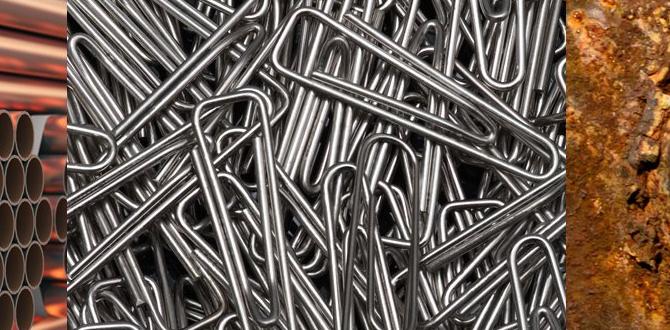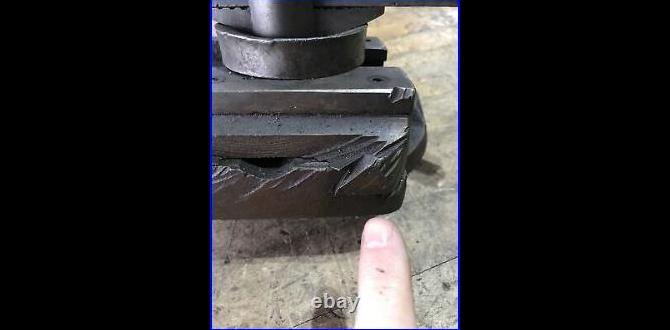Quick Summary: For your 1/8 inch carbide end mill, effective chip evacuation is key to clean cuts and tool longevity, especially in materials like polycarbonate. This guide shows you how to master it.
Carbide End Mill 1/8 Inch: Mastering Chip Evacuation for Perfect Cuts
Hey everyone, Daniel Bates here from Lathe Hub! Ever run a 1/8 inch carbide end mill and end up with a mess? Chips sticking, a rough finish, or worse, a broken tool? It’s a common challenge, especially when you’re new to milling. Don’t worry, it’s not as complicated as it seems. Proper chip evacuation is like giving your end mill a clear path to do its best work. We’ll break down exactly how to achieve it, step by step, so you can get those clean, precise cuts you’re after. Let’s get milling!
Why Chip Evacuation Matters More Than You Think
When your 1/8 inch carbide end mill is spinning away, it’s like a tiny, high-speed chisel removing material. As it cuts, it creates chips. If these chips don’t get out of the way quickly, they can cause a whole heap of trouble. Think of it like trying to dig a hole when the dirt you’re removing piles up around your shovel. It makes the job harder, slower, and can damage your tools.
For a small diameter like 1/8 inch, these issues can be amplified. The flutes (the spiral grooves on the end mill) are narrow. If they get clogged with chips, here’s what can happen:
- Poor Surface Finish: Re-cutting chips leads to rough, uneven surfaces.
- Increased Heat: Chips trapped in the cut act like an insulator, causing the tool and workpiece to overheat. This can dull your end mill and warp your material.
- Tool Wear and Breakage: The extra force and heat place immense stress on the tiny cutting edges of your 1/8 inch carbide end mill, leading to premature wear or snapping the tool.
- Workpiece Damage: Overheating can melt or deform softer materials like plastics.
For specific materials like polycarbonate, which can be prone to melting, good chip evacuation is absolutely critical. We want those chips to fly out, leaving a clean path, not to get smeared around.
Understanding Your 1/8 Inch Carbide End Mill for Chip Control
Before we dive into techniques, let’s quickly understand what makes a 1/8 inch end mill work. These small tools are often made of carbide because it’s hard and can withstand higher cutting temperatures than high-speed steel (HSS). This hardness is great for cutting, but carbide can be brittle, making it susceptible to breakage if not managed correctly.
Key Factors for Effective Chip Evacuation
Several elements play a role in ensuring your chips clear the cutting zone effectively. It’s a combination of the tool itself, your machine’s settings, and how you approach the cut.
1. End Mill Geometry: The Flute Design
The shape and number of flutes on your end mill are designed to help evacuate chips. For a 1/8 inch end mill, you’ll typically see:
- Two Flutes (2-Flute): These have more clearance between the flutes, making them excellent for chip evacuation. They are often preferred for materials that produce long, stringy chips, like aluminum and plastics such as polycarbonate. The larger chip gullets allow chips to escape more easily.
- Four Flutes (4-Flute): These generally provide a better surface finish and can handle higher feed rates in harder materials because they have more cutting edges. However, their tighter flutes can sometimes struggle to evacuate chips efficiently, especially in softer, gummy materials. For a 1/8 inch size, they can work well if you manage your chip load and cutting fluid.
When choosing an end mill for materials like polycarbonate, a 2-flute end mill with a high helix angle is often a great choice for pushing chips out effectively. For hobbyists and light-duty work, a standard 2-flute or 4-flute carbide end mill will work, but we need to be mindful of how we use it.
2. Proper Spindle Speed (RPM)
Spindle speed affects how quickly the end mill rotates. A general rule of thumb is to use higher RPMs for smaller diameter tools and softer materials. For a 1/8 inch carbide end mill, you might be running at RPMs much higher than for a larger end mill. The goal is to achieve a surface speed that efficiently cuts the material without generating excessive heat. However, too high an RPM without adequate chip load can lead to rubbing instead of cutting, which is bad for chip evacuation.
A good starting point for a 1/8 inch carbide end mill in many plastics and softer metals might be in the range of 10,000 to 20,000 RPM, but always consult the tool manufacturer’s recommendations or use a reliable CNC speeds and feeds calculator when available. For instance, Machinery’s Handbook is a great resource for this, though it can seem daunting at first.
MachinistsHelp.com offers a practical guide to understanding speeds and feeds.
3. Appropriate Feed Rate (IPM/mm/min)
Feed rate is how fast you move the end mill through the material. This is crucial for chip evacuation. You need to feed fast enough to create a proper chip. If you feed too slowly, the end mill will rub against the material, producing dust instead of chips. This dust can pack into the flutes and cause the problems we discussed.
For a 1/8 inch end mill, you need to find the “sweet spot.” Too aggressive a feed rate can overload the tool, causing it to break. Too timid a feed rate will result in poor chip formation and evacuation. You want to hear a consistent, crisp cutting sound. Think of it as taking a substantial chip with each rotation.
A general guideline is to aim for a chip load (the thickness of the chip removed by each cutting edge per revolution) that is appropriate for the material and the end mill. For a 1/8 inch carbide end mill, chip loads can range from 0.001″ to 0.004″ or more, depending on the material and number of flutes.
4. Depth of Cut (DOC) and Stepover
How deep you plunge or step down into the material (Depth of Cut, DOC) and how much you move sideways on each pass (Stepover) also impact chip evacuation.
- Shallow Depth of Cut: Generally better for chip evacuation with small end mills and harder materials. It allows chips more room to escape.
- Conservative Stepover: For full-depth cuts or when dealing with tricky-to-machine materials, a smaller stepover ensures the cutting forces are manageable and chips can clear from the flutes.
For a 1/8 inch end mill, especially in plastics, using a shallower DOC and a moderate stepover is often a good strategy to ensure clean cuts and prevent chip recutting.
5. Cutting Fluid and Air Blast
This is where active chip evacuation comes into play. For many materials, especially metals and some plastics, using a cutting fluid or coolant can dramatically improve chip evacuation and extend tool life.
- Coolants/Lubricants: These flush chips away from the cutting zone, keep the tool and workpiece cool, and reduce friction. For milling operations, a mist coolant or a soluble oil is often used.
- Air Blast: A directed stream of compressed air can be very effective at blowing chips away, especially in materials that don’t require extensive cooling. This is particularly useful for plastics and composites.
For polycarbonate, a good air blast is often sufficient and avoids the messy cleanup of liquid coolants. Ensure the air is directed to blow chips away from the cut and out of the flutes.
6. Machine Rigidity and Tramming
A rigid machine is essential. If your milling machine has play in the Z-axis or spindle, it can lead to inconsistent cutting depths and chip loads, which hinders proper evacuation. Ensure your spindle is properly “trammed” – meaning it runs perfectly square to your worktable.
Similarly, make sure your workpiece is held securely. A vibrating workpiece will lead to chatter and poor chip formation.
Troubleshooting Common Chip Evacuation Issues
Let’s look at some problems you might encounter and how to fix them:
Problem: Chips Re-cutting or Smearing
- Cause: Insufficient feed rate, tool dullness, or ineffective flushing.
- Solution: Increase feed rate slightly to achieve a proper chip load. Check if the end mill is sharp. Ensure coolant or air blast is effectively clearing chips. Try a shallower depth of cut.
Problem: Overheating or Melting (Especially in Plastics)
- Cause: Excessive spindle speed for the feed rate, inadequate cooling, or feeder too slow.
- Solution: Reduce spindle speed, increase feed rate, or ensure adequate air blast/coolant. Use a tool geometry optimized for chip evacuation (e.g., 2-flute high helix).
Problem: Tool Breaking
- Cause: Feeding too fast, too deep a cut, chip recutting causing jamming, or brittle material chipping.
- Solution: Reduce feed rate, reduce depth of cut. Ensure consistent chip evacuation. Take lighter passes. Check for machine rigidity issues.
Carbide End Mill 1/8 Inch, 1/2 Shank Extra Long for Polycarbonate: A Specific Case
You might see listings for tools like “carbide end mill 1/8 inch 1/2 shank extra long for polycarbonate chip evacuation.” This description highlights specific features beneficial for your exact needs. Let’s break it down:
- Carbide: Great for rigidity and heat resistance.
- 1/8 Inch: The cutting diameter – it’s small and requires careful feed/speed settings.
- 1/2 Shank: This is the diameter of the tool holder end. It’s a common size that provides good rigidity for the 1/8 inch cutting head.
- Extra Long: This refers to the flute length or overall length. An extra-long end mill allows you to cut deeper into a workpiece. However, these tools can be less rigid due to their length. This makes chip evacuation even more critical, as the longer flutes need to be kept clear to prevent chatter and breakage.
- For Polycarbonate Chip Evacuation: This explicit mention means the tool’s design (likely 2-flute, high helix) is optimized to push chips out of the way, reducing melting and ensuring a clean cut in this specific plastic.
When using an extra-long end mill, especially in a material prone to melting like polycarbonate, it’s wise to:
- Use a shallower depth of cut than you might with a standard tool.
- Ensure your air blast or mist coolant is very effective.
- Check your machine’s rigidity, as longer tools can amplify any flex.
- Consider a slightly slower feed rate to manage the reduced rigidity if chatter occurs.
Practical Steps for Better Chip Evacuation
Here’s a checklist to follow every time you set up a job using a 1/8 inch carbide end mill, especially for tricky materials like polycarbonate:
Step-by-Step Guide:
- Select the Right End Mill: For plastics and materials that gum up, a 2-flute, high-helix design is often best. For tougher metals where you need a better finish and can manage chip load, a 4-flute can work.
- Secure Your Workpiece: Use clamps, a vise, or double-sided tape to ensure the workpiece is absolutely stable. No movement allowed!
- Set Appropriate Speeds and Feeds: Consult a reliable source or calculator. Start conservatively if unsure. For polycarbonate and 1/8″ end mills, aim for high RPMs (e.g., 15,000-25,000 RPM) and a feed rate that creates audible, distinct chips, not dust. A typical starting point for polycarbonate might be around 15,000 RPM and 0.0015″ chip load per tooth (which translates to a feed rate).
- Set Depth of Cut (DOC) and Stepover: For initial tests and materials like polycarbonate, keep DOC shallow (e.g., 0.050″ to 0.100″). Stepover can be 50% of the diameter (0.0625″).
- Apply Coolant/Air Blast: Turn on your air blast or mist coolant before the tool starts cutting. Aim it directly at the cutting zone to blow chips away from the end mill and out of the flutes.
- Start the Cut: Begin the milling operation. Listen to the sound. A consistent, sharp cutting sound is good. A high-pitched whine or a dull scraping sound means something isn’t optimized.
- Monitor: Watch the chips being produced. Are they fine dust, or well-formed curly/segmented chips? Are they being blown out of the flutes? Is the workpiece overheating or melting?
- Adjust as Needed:
- Chips are too large/not clearing: Slightly increase feed rate or decrease DOC.
- Material is melting/gumming up: Increase air flow/coolant. Decrease spindle speed slightly if heat is excessive, but ensure you maintain sufficient chip load by speeding up the feed rate accordingly (or you’ll just rub more). Experiment with a 2-flute high-helix end mill if you aren’t using one.
- Tool chatter or vibration: Reduce feed rate, reduce DOC, or check machine rigidity. Ensure spindle is well-trammed.
Material Considerations Table
Different materials require different approaches to chip evacuation. Here’s a general guide, but always research specific material properties:
| Material Type | Typical Chip Behavior | Recommended End Mill (1/8″ Carb.) | Chip Evacuation Strategy | Notes for 1/8″ Size |
|---|---|---|---|---|
| Polycarbonate | Can be stringy, prone to melting. | 2-Flute, High Helix (30-45 degrees) | Strong Air Blast, Mist Coolant (optional) | High RPM, moderate feed to create distinct chips. Avoid rubbing. Shallow DOC. |
| Aluminum (Soft Alloys) | Stringy, gummy. | 2-Flute, High Helix | Flood Coolant or Mist, Air Blast | Moderate RPM, higher feed rate. Keep flutes clear. |
| Acrylic | Can be brittle or melt. | 2-Flute or Single Flute, Polished Flutes | Air Blast, Mist Coolant | Lower RPM than Polycarbonate, moderate feed. Very shallow DOC advised. |
| Brass | Brittle chips, good chip breaking. | 2-Flute or 4-Flute | Dry (often), Air Blast | Higher cutting speeds possible, moderate feed. |
| Steel (Mild) | Can be stringy or chip-break well depending on alloy. | 4-Flute (for rigidity/finish) or 2-Flute (for chip clearance) | Flood Coolant is highly recommended. | Lower RPM than plastics/aluminum, moderate feed. Requires rigid setup and good coolant flow. |
Always refer to tool manufacturer specifications for optimal speeds and feeds. Resources like Sandvik Coromant’s tooling selector can provide excellent starting points for various materials.
Advanced Tips for the Hobbyist Machinist
As you get more comfortable, here are a few extra things to consider:
- Tool Coating: Some end mills come with coatings (like TiN, TiAlN) that can improve performance, reduce friction, and help with chip flow, especially in tougher materials.
- Center Cutting vs. Non-Center Cutting: Most end mills used for profiling and slotting are center-cutting, meaning they can plunge straight down. This is generally what you’ll want for most operations.
- Helix Angle: A high helix angle (30-45 degrees) on a 2-flute end mill is excellent for pushing chips up and out of the cut, reducing the chance of recutting them. This is particularly helpful in softer metals







